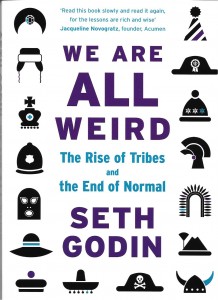The one sentence summary
Weird is the new normal, so only companies that work that out have any chance of survival.
WHAT THE BOOK SAYS 
- Let’s face it – we’re all weird. So why are companies still trying to build products for the masses? Why are we still acting as though the masses even exist?
~ Mass is what allowed us to become efficient. It’s what we call the undifferentiated, the easily reached majority that seeks to conform.
~ Normal is what we call the people in the middle. It is localised – what’s normal here is not necessarily normal somewhere else.
~ Weird is what we call people who aren’t normal. This means by choice, rather than unusual by nature or physique.
~ Rich refers to anyone who can make choices, who has enough resources to do more than merely survive.
- Everything about capitalism, industry and education trains people to conform and shun outliers. This rewards companies that create efficient mass market products.
- There are four forces for weird:
1. Creation is amplified. Anyone can produce pretty much anything, and reach someone else immediately via the internet.
2. Being rich allows us to do what we want, and we want to be weird. Standing out takes time, money and confidence. More of us now have all three.
3. Marketing is far more efficient at reaching the weird. The long tail isn’t just a clever phrase – it’s an accurate description of the market for just about everything.
4. Tribes are better connected. Because you can now find others who share your interests, weird is perversely becoming more normal.
WHAT’S GOOD ABOUT IT
- The book challenges the reader do make two decisions: to create for and market to the fast-increasing population that isn’t normal; and to encourage people to do what’s right, useful and joyful, as opposed to what the system suggests.
- Antelopes don’t have hobbies. You need to be rich to be weird.
- 2,200 years ago you needed to work 50 hours to buy an hour of light from a lantern. You can do that today in about half a second.
- The bell curve is spreading. The bump of normal in the middle isn’t gone, but it’s much flatter, and flanked by many more weird outlying groups.
- There are 10 billion items for sale in New York alone. 500 years ago there were 200.
WHAT YOU HAVE TO WATCH
- Not much. This is a celebration of originality and individuality, and larger companies involved in old-fashioned mass production should take note.
